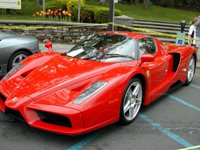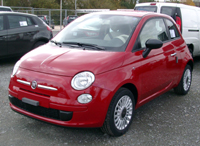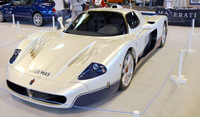
Italian Cars
Italian cars, in particular sports cars and luxury cars, enjoy a reputation worldwide for design
and speed. The Italian automobile industry had its beginnings in 1884 when Enrico Bernardi built a tricycle
car that ran on petrol fuel. In 1896 the first actual Italian car was produced. Three years later, Giovanni
Agnelli and his partners founded Fiat and produced their first model. Italy is now one of the top five
automobile manufacturers in the world, and Fiat dominates the industry with over 90% of overall
production.
1. Alfa Romeo If you want to learn more about the Italian car industry, Wikipedia offers a number of articles on each of the Italian car
manufacturers, as well as the industry in general. Alfa Romeo Automobiles was founded on June 24, 1910 in Milan. Initially named ALFA, the
company was an offshoot of Società Anonima Italiana Darracq (SAID), founded in 1906 by Frenchman Alexandre
Darracq and some Italian investors. ALFA produced its first car, the 24 HP, in 1910, and a year later
entered two cars in the Targa Florio motor racing event. This began a long association with motor
racing. Alfa Romeo Automobiles was founded on June 24, 1910 in Milan. Initially named ALFA, the
company was an offshoot of Società Anonima Italiana Darracq (SAID), founded in 1906 by Frenchman Alexandre
Darracq and some Italian investors. ALFA produced its first car, the 24 HP, in 1910, and a year later
entered two cars in the Targa Florio motor racing event. This began a long association with motor
racing.In 1915, Nicola Romeo took over as director, and the company halted car production to manufacture military hardware. In 1920, the company name was changed to Alfa Romeo. Mussolini commandeered the company in 1941 to build vehicles for the wealthy, and after the end of the war, Alfa Romeo reorganized and began mass-producing small cars. In 1954, they developed the Alfa Romeo Twin Cam engine, which they manufactured for the next forty years. Since its inception, the cpmpany has built a reputation for producing fine quality, expensive sports cars. Alfa Romeo has successfully competed in many different types of motor racing, including Formula One, Grand Prix motor racing, sports car and touring car racing, and rallies. The company produced its first racing car in 1913, and won the inaugural Grand Prix world championship in 1925. When the Alfa Romeo racing team was privatised, team leader Enzo Ferrari named it Scuderia Ferrari. During the 1960s and 1970s Alfa Romeo produced a number of sports cars, but the brand was sold to the Fiat Group in 1986. Models currently in production include the MiTo, Giulietta, 159, GT, Brera, Spider, and 8C Spider. 2. Ferrari  Ferrari was founded in 1929 by Enzo Ferrari under the name Scuderia Ferrari. Initially it
was the racing team for Alfa Romeo, until financial constraints forced Alfa to withdraw their cars in
1933. Ferrari manufactured racing cars and sponsored drivers before expanding into the road vehicles
market in 1947. This move was primarily to fund its racing ventures, especially in Formula One where it
was highly successful. Ferrari was founded in 1929 by Enzo Ferrari under the name Scuderia Ferrari. Initially it
was the racing team for Alfa Romeo, until financial constraints forced Alfa to withdraw their cars in
1933. Ferrari manufactured racing cars and sponsored drivers before expanding into the road vehicles
market in 1947. This move was primarily to fund its racing ventures, especially in Formula One where it
was highly successful.The first Ferrari race car was entered in the 1940 Mille Miglia race. Ferrari is the only team to have competed in the Formula One World Championship continuously since it was founded in 1950. In 1973, Ferrari retired from sports car racing to concentrate exclusively on Formula One. With Michael Schumacher on the team, Ferrari dominated Formula One racing from 2000 through 2004. Scuderia Ferrari holds nearly every Formula One record. According to Wikipedia, Ferrari's records include 15 World Drivers Championship titles, 16 World Constructors Championship titles, 209 Grand Prix victories, 4925.27 points, 622 podium finishes, 203 pole positions, and 218 fastest laps in 776 Grands Prix contested. Ferrari entered the road car market in 1947. Two years later, it entered the grand touring market, which still accounts for the majority of Ferrari sales. In 1962 it entered the super car market, and later produced one-off models for wealthy clients. Ferrari licenses many products under its brand, including clothing, eyewear, perfume and cologne, watches, bicycles and electronics. The Ferrari museum, Galleria Ferrari, features a variety of displays that document the company's achievements. Enzo Ferrari died in 1988, causing the value of both used and new model Ferraris to rise. In 1969 Fiat purchased a 50% stake in Ferrari, as well as Alfa Romeo. 3. Fiat  Fiat (Fabbrica Italiana Automobili Torino) was founded in 1899 by a group of investors which
included Giovanni Agnelli. The company grew quickly, and, 25 years later, dominated the Italian car
market. Fiat produces a range of cars including small road cars, sports cars, vans and trucks. Fiat has
won the European Car of the Year award twelve times. Fiat (Fabbrica Italiana Automobili Torino) was founded in 1899 by a group of investors which
included Giovanni Agnelli. The company grew quickly, and, 25 years later, dominated the Italian car
market. Fiat produces a range of cars including small road cars, sports cars, vans and trucks. Fiat has
won the European Car of the Year award twelve times.Fiat also has a significant presence overseas. Since the 1950s, the company has worked to establish motor industries in a number of countries. Fiat-based cars are constructed in Bulgaria, Poland, Russia, Spain, Serbia, Turkey, Ethiopia, Egypt, Argentina, Brazil, South Africa, India, Pakistan, Sri Lanka and Korea. Fiat has a history of buying up its competitors in the Italian car industry. In 1967, it purchased Autobianchi, and, two years later, purchased controlling interests in Ferrari and Lancia. In 1986, Fiat acquired Alfa Romeo, and in 1993, Maserati. Consequently, Fiat is now the largest Italian car manufacturer, and the world's sixth largest. In 1979, the company spun off its various businesses into separate entities and became a holding company. Fiat is now a conglomerate, owning businesses in a wide variety of industries. Currently, it is Italy's largest industrial organization. 4. Lamborghini  Automobili Lamborghini was founded in 1963 by manufacturing magnate Ferruccio Lamborghini. A
former mechanic during World War II, Lamborghini built a tractor business using leftover military
hardware. By 1955, his tractor company was one of Italy's largest farming equipment manufacturers. Finding
himself in a position to indulge his passion for luxury cars, Lamborghini began buying Alfa Romeos,
Lancias, Maseratis, and Ferarris. He decided to build the perfect grand touring car, and after several
years of working with top designers, the Lamborghini 350GTV was unveiled at the 1963 Turin Motor Show. Automobili Lamborghini was founded in 1963 by manufacturing magnate Ferruccio Lamborghini. A
former mechanic during World War II, Lamborghini built a tractor business using leftover military
hardware. By 1955, his tractor company was one of Italy's largest farming equipment manufacturers. Finding
himself in a position to indulge his passion for luxury cars, Lamborghini began buying Alfa Romeos,
Lancias, Maseratis, and Ferarris. He decided to build the perfect grand touring car, and after several
years of working with top designers, the Lamborghini 350GTV was unveiled at the 1963 Turin Motor Show.Lamborghini was now a player in the automobile manufacturing industry, and over the years the company gained acclaim for their high-performance, stylish models, including the 350GT, 400GT, Miura, Espada, Islero, Jarama, Urraco, and the Countach. But after a decade of impressive growth, the 1973 oil crisis had a devastating effect on sales. In 1972, Lamborghini had sold his ailing tractor business to a rival company and offloaded 51% of Automobili Lamborghini, although he continued working at the factory. Then in 1974, he sold his remaining shares and walked away from the company he founded. Bankruptcy in 1978 was followed by three changes in ownership – the Swiss Mimram Brothers (1984-87), the Chrysler Corporation (1987-1994), and Indonesian company MegaTech (1994-1998). Lamborghini continued to falter until it was acquired in 1998 by a subsidiary of the Volkswagen Group. Despite foreign ownership, Lamborghini continued to employ Italian designers, launching the Silhouette, Jalpa, LM002, Diablo, Murciélago, Gallardo and Reventón. The Lamborghini factory in Sant'Agata Bolognese still produces small runs of its four latest models. 5. Lancia  Lancia Automobiles was founded in 1906 by racing drivers Vincenzo Lancia and Claudio
Fogolin. The company has a long history of producing distinctive cars and also performing well at motor
rallies. Upon Vincenzo's death in 1937, his wife and son took charge of the company. Lancia became famous
for its many innovations in the automobile industry. These include: Lancia Automobiles was founded in 1906 by racing drivers Vincenzo Lancia and Claudio
Fogolin. The company has a long history of producing distinctive cars and also performing well at motor
rallies. Upon Vincenzo's death in 1937, his wife and son took charge of the company. Lancia became famous
for its many innovations in the automobile industry. These include:
6. Maserati  Maserati was founded in 1914, in Bologna by the Maserati brothers, Alfieri, Bindo, Carlo,
Ettore, and Ernesto. Three of the brothers had built Grand Prix cars for Diatto, and in 1926, they created
the first Maserati. One of their early models, driven by Alfieri Maserati, won the 1926 Targa Florio. In
1937, the brothers sold their shares to Adolfo Orsi, although they continued working for the company as
engineers. Ten years later, they finally left the company and founded a rival company, OSCA. After 1957,
Maserati began focusing on building road cars. Maserati was founded in 1914, in Bologna by the Maserati brothers, Alfieri, Bindo, Carlo,
Ettore, and Ernesto. Three of the brothers had built Grand Prix cars for Diatto, and in 1926, they created
the first Maserati. One of their early models, driven by Alfieri Maserati, won the 1926 Targa Florio. In
1937, the brothers sold their shares to Adolfo Orsi, although they continued working for the company as
engineers. Ten years later, they finally left the company and founded a rival company, OSCA. After 1957,
Maserati began focusing on building road cars.Like several other Italian car manufacturers, Maserati has a long history of takeovers and reinvention. In 1968, the French car manufacturer, Citroën, purchased the company. After Citroën went bankrupt in 1974, Italian government funds kept the company afloat. In 1975 Argentinean Alessandro de Tomaso took over the company. Later, Chrysler purchased part of Maserati, and, in 1993, it was sold to Fiat. Fiat later relinquished control to Ferrari, also a Fiat-owned company, and Maserati cars regained the popularity they had lost in the intervening years. In 2005 Fiat Auto regained control of Maserati and merged it with Alfa Romeo. Maserati cars performed well at motor racing events in the 1940s and 50s. Maserati won the Indianapolis 500 twice, in 1939 and 1940, the only Italian car manufacturer to achieve this distinction. Racing victories in the 1950s included the world championship in 1957. To read one of our readers' list of top 5 Italian cars, complete with videos, please click on Italian Cars - Jay's Top Five. |
Italy Travel Italy Trips Holidays to Italy Hotels in Italy Luxury Hotels Couch Surfing Walking Tour Bardolino Puglia Holidays Italy Photos Valley of the Temples 2 Valley of the Temples Holidays in Florence Tuscany Bicycle Tours Florence Photos Venice Tourist Attractions